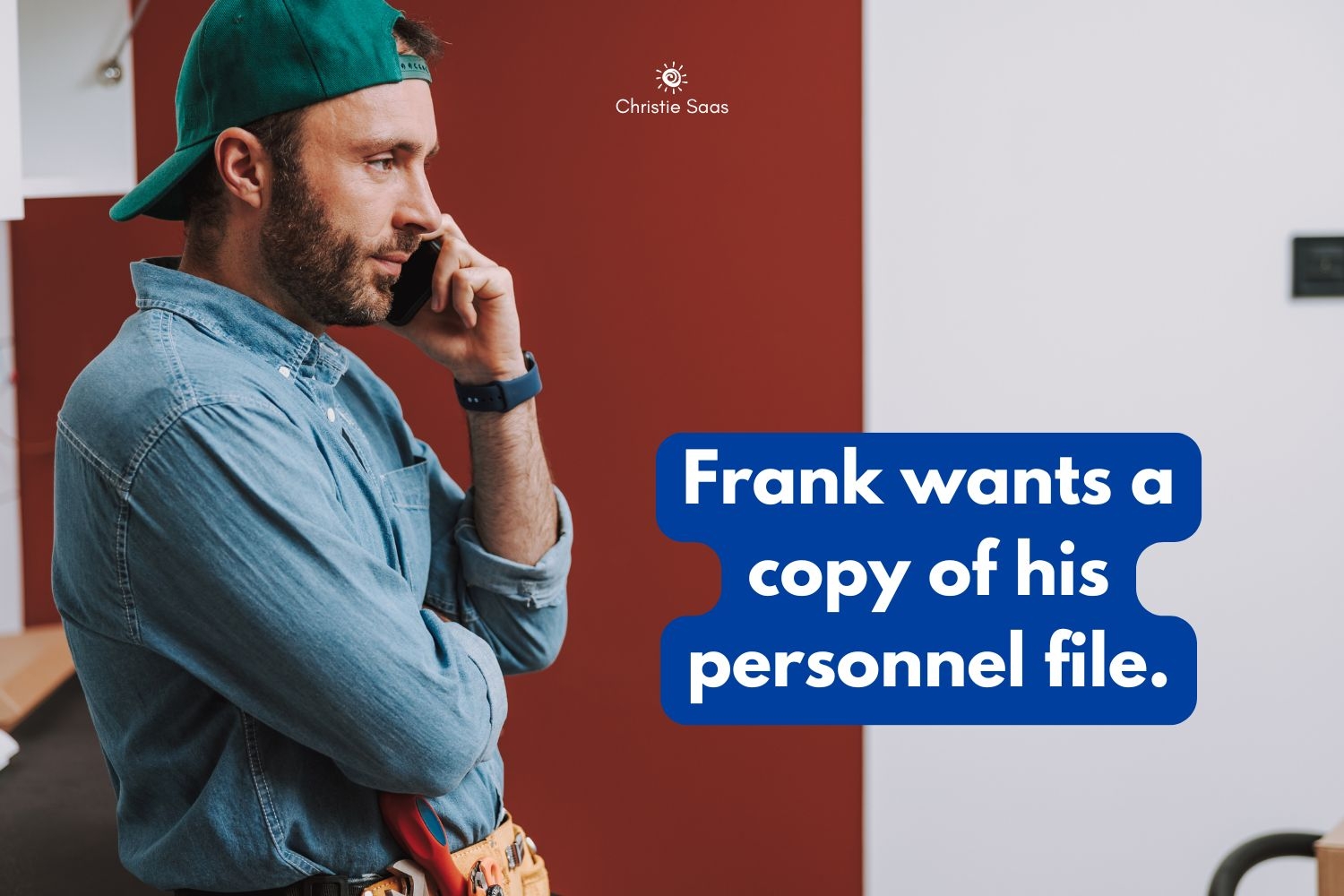Frank wants a copy of his personnel file

The official personnel file is one of the most useful collections of information about an employee and often the files with the biggest mess. From time sheets to vacation requests, from letter of employment to annual evaluations, the volume of information a non-profit executive director is expected to maintain can quickly become unwieldy. The whole thing can get more confusing when trying to decide what is kept digitally and what is kept in hard copy.
Not too much. Not too little.
The pressure to keep the right information often leads an executive director to keep more information than is necessary. A hot mess of files with too much information will set-up an executive director for an unwanted late-night clean-up session when an employee asks for a copy of everything in their file, or succinct documents are needed for a legal matter.
While every executive director will develop the filing system that works best for them, sometimes having a core structure to use when getting started will ease the worry of wondering if you are keeping the right information.
6 core folders and one loose file.
I start each operating year with a 6-part digital folder structure, for all my employee files, including my own. That means in each folder for, say, Jane Smith, there will be one sub-folder for each operating year, and in each of those, the following 6 folders.
Admin
Working digitally, I use the admin folder to hold all the documentation related to the employee’s position, wage, benefits, and required work hours. When an employee is hired, this folder includes the letter of offer and signed contract. Over the years, as an employee’s wage or vacation hours increases, I keep digital copies of all letters.
At my non-profit, I work with a payroll provider. Any correspondence I send to them about changes to an employee’s wage or work hours is also included here.
When an employee leaves the organization, whether permanently, or temporarily such as for a parental leave, that documentation is kept in this folder.
Time Sheets
I’ve written before about the importance of time sheets. You can read that post HERE. All my time sheets are completed and submitted digitally, then signed and filed also digitally. This folder is incredibly valuable when checking any sort of historical information. It is also the folder I pull, for each employee, to submit to our auditor as corresponding documentation to match payroll records.
Vacation
I use a policy to track how an employee can request vacation days, and the digital documentation they need to submit. That documentation is stored in the Vacation folder. Since employees take holidays in larger chunks of time, this folder is a little lean. It will only have about 3-4 requests and approvals for the year.
PD (Professional Development)
Like vacation time, I use a policy to track how an employee can apply for professional development. I store all that digital documentation in the PD folder. This folder can get a little robust if an employee is required to submit an interim, or final, PD follow-up report.
Workplan
Each employee is required to complete their own work plan for each operating year. The workplan, is a combination of several different components. I find there is a lot of back and forth with a digital work plan document, and this folder can get a little bigger with version history and then the final (digitally) signed copy.
Evaluation
Finally, each employee receives a written report at the end of the year, after we’ve completed their annual evaluation. Like the workplan, this folder gets filled with different digital versions of the evaluation document, supporting documents or reports, and the version history as it goes back and forth being read and then signed.
Loose Document
I keep one single document loose, in an employee’s digital official personal file. That is the Years of Service Document. I keep the file, ‘loose’, outside of all the operating years folders so that it can be easily referenced and updated as needed. This is very helpful when trying to quickly reference when an employee is eligible for the next step in vacation time, or other benefits.
…
When talking about what documentation to keep, its also important to talk about what NOT to keep.
Not my file.
I build out the digital official employee personnel file with the premise that it is the employee’s record, not mine. That means I do not keep any of my own notes in these folders. I maintain a private set of digital folders, that are for my eyes only. While there is little need to duplicate the full folder structure, I do keep any HR-related documentation as it pertains to hiring, firing, wages, and performance evaluations. These are my own, un-edited, notes, used for my own reference. I will use these notes to write any formal report about an employee. The formal, official report is kept in the official personnel file.
I maintain my own private notes in a folder that will leave with me, when I leave the organization. I do not want the next ED to read my notes, and potentially mis-interpret what I meant. So, only the official report is left in the official file. But in an emergency, if someone asks, I will have my notes to look back on.
Thin hard copy folder.
I want to say I completely trust the security of my organization’s digital filing system. The reality is that nothing online is ever really safe. So, I never keep digital copies of any information that could put an employee at risk for identity theft.
That means, for each employee, for each operating year, I do maintain a very slim hard copy folder of documents that have birthdates, SIN/SSN, etc. I never send those documents digitally to our payroll provider, and I make sure they are kept in a locked file cabinet. Since these hard copy documents are unlikely to be needed for legal matters, I have a policy for how long they are kept, and when they are sent for secure shredding.
The work will get done eventually.
The truth about a digital filing system is that an organized folder system is needed most when an executive director has the least time. No one wants to launch into an all-night digital file clean up, especially if they are writing a grant application, working on an event, or trying to organize year end.
Whether you choose to use my 6-core folder plan, or a format of your own, having a plan in place, that you can set-up and use year after year will make the official personnel file clear, tidy, and easy to use.
Your turn.
Your turn. What format do you use for your human resources files? Are you using a system that makes it easy to respond to a request, with little delay? I want to know! Please use the form on the side of the page to let me know, ..or send me an email, ..or message me on socials.
-Christie
…
Hi, I'm Christie. I help executive directors develop the systems and processes needed to run a non-profit.
I learned early in my career, there is no non-profit school. Browsing the internet for resources from big-city experts doesn’t provide practical solutions to balance the budget, write a work plan, or conduct an employee evaluation. Leadership development tips don’t really resonate when you are also taking out the recycling and cleaning the washroom.
I created ChristieSaas.com so non-profit leaders never need to wonder how to do the job – no matter how big or small that job is.
I have been the executive director of small-team, small-budget, non-profits for 20+ years. My experience isn’t theory. It is the real, operational, and practical solutions I use every day.
I love my work and I want to help you love yours too.
© Christie Saas 2024 All Rights Reserved
…
Want to learn more?
Start with one of my free resources.


